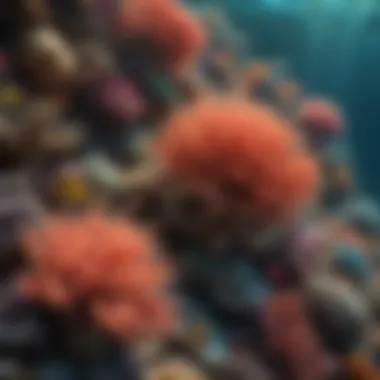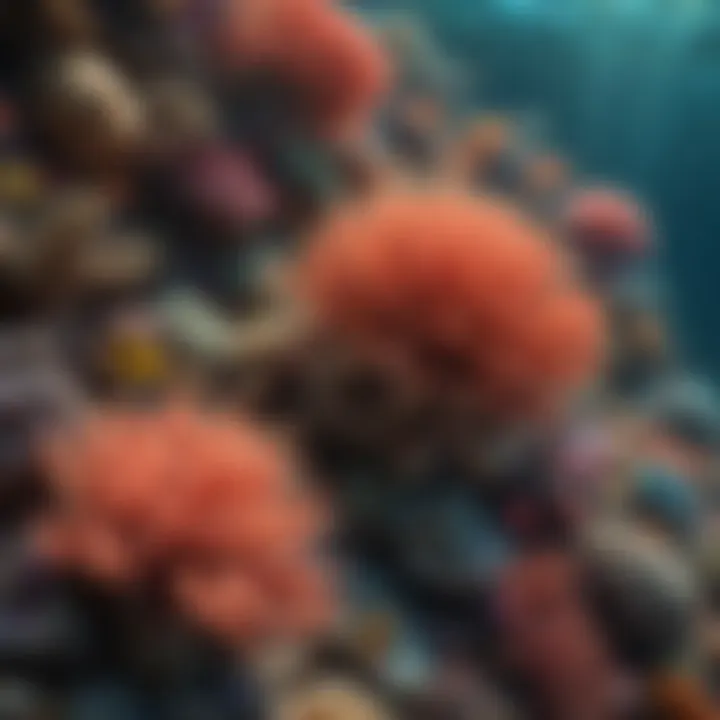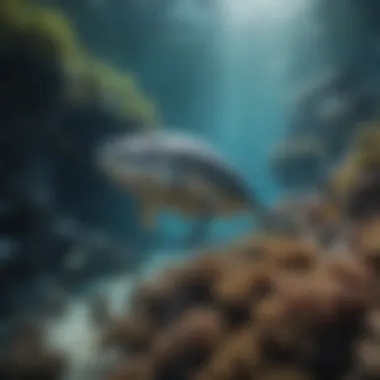Conservation Efforts to Protect Marine Life


Intro
Marine conservation has become an urgent topic as the threats to marine life escalate. Oceans cover over 70% of our planet and are home to countless species, many of which face extinction due to human activities. Understanding the significance of these ecosystems is essential. Healthy marine environments support biodiversity, provide food, and regulate climate. However, factors such as pollution, overfishing, habitat destruction, and climate change jeopardize these critical resources.
Organizations and governments worldwide strive to implement strategies to counteract these threats. The focus is on creating sustainable practices that ensure the longevity of marine species and habitats. This involves not just policies and regulations, but also community involvement and technological advancements.
The upcoming sections will examine these conservation efforts in detail, discussing what is currently being done to protect marine life and what more can be achieved.
Foreword to Marine Conservation
Marine conservation plays a pivotal role in safeguarding the world’s oceans and their inhabitants. The oceans cover more than 70% of the Earth's surface and are essential for sustaining life. They provide food, livelihoods, and oxygen, and they regulate the climate. Awareness of marine conservation is crucial. A healthy marine ecosystem supports biodiversity, provides numerous resources, and contributes to global economies. Without it, we risk losing irreplaceable marine species and the critical services they provide.
The importance of this topic cannot be overstated. Understanding marine conservation allows us to address the severe challenges faced by marine life today. Conservation efforts aim to preserve these environments not just for their aesthetic or intrinsic value but for their ecological significance. Preserving biodiversity also ensures resilience against environmental changes, such as climate shifts and pollution.
In this article, we will explore various aspects of marine conservation—from examining the current state of marine life and the threats it faces, to discussing the strategies implemented to protect marine ecosystems. This comprehensive approach ensures that we appreciate the complexities of marine conservation efforts and the collaborative actions necessary to make a measurable impact.
The Importance of Marine Biodiversity
Marine biodiversity refers to the variety of life found in the ocean, including species diversity, genetic variability, and ecosystem variety. A rich biodiversity is necessary for maintaining ecological balance. For instance, diverse species contribute to functions like nutrient cycling and habitat provision. Their interactions create a network of life that supports a healthy ocean environment.
Moreover, marine biodiversity impacts human activities. Fish populations, for example, are vital not only as a food source but also for the economy of many coastal communities. Protecting biodiversity can enhance fisheries, boost tourism, and improve resilience against changes in the climate.
Current State of Marine Life
The current state of marine life is troubling. Overfishing, habitat loss, and pollution are creating significant declines in marine populations across the globe. Research shows that many fish stocks are at or below sustainable levels, threatening both the ocean's future and human livelihoods tied to fishing.
Pollution—particularly plastic waste and agricultural runoff—further complicates the plight of marine life. > "More than 8 million tons of plastic waste end up in the oceans every year, harming marine ecosystems and entering the food chain."
Additionally, almost half of the world's coral reefs are dead or dying. This degradation affects not just marine species but also the economic benefits derived from tourism and fishing. Understanding these issues is essential for implementing effective conservation strategies. \n As we proceed through this article, the multifaceted challenges and the considered strategies to mitigate them will be further explored, highlighting the urgency of concerted action to save marine life.
Key Threats to Marine Ecosystems
Marine ecosystems face numerous current threats impacting biodiversity and overall health. Understanding these threats is essential for effective conservation strategies. Each threat presents unique challenges to marine life and calls for tailored responses.
Overfishing and Its Consequences
Overfishing is a significant threat to marine resources. When fish and other marine species are harvested at rates faster than they can reproduce, collapses in fish populations can occur. This not only disrupts the balance of marine ecosystems but also affects local economies that rely on fishing. Species such as tuna and cod have seen dramatic declines due to overfishing. Homework on this topic reveals long-term ecological and economic consequences. If fish populations do not recover, entire communities may face food shortages and loss of income, leading to increased poverty.
Pollution and Its Impact
Pollution affects marine life through various channels. It can lead to harmful algal blooms, depleted oxygen levels, and direct harm to marine species.
Plastic Pollution
Plastic pollution is notorious for its extensive impact on marine environments. Millions of tons of plastic enter the oceans each year. This pollution affects marine animals who mistakenly ingest plastics or become entangled. Key characteristics such as durability and low density make plastics pervasive in marine ecosystems. The advantage of pointing this out is to highlight that solutions like reducing plastic use can directly benefit marine health.
Nutrient Runoff
Nutrient runoff refers to excess fertilizers from agricultural practices entering waterways. This runoff leads to nutrient enrichment in oceans and can cause harmful algal blooms. The key characteristic here is how it triggers drastic changes in ecosystems, particularly coastal regions. The unique feature of nutrient runoff is its ability to create dead zones, areas devoid of life due to low oxygen levels. Addressing this is essential for sustainable marine environments.
Chemical Contaminants
Chemical contaminants from industrial, agricultural, and urban sources are harmful to marine ecosystems. These toxic substances enter through various pathways, affecting all levels of the food chain. The key characteristic of these contaminants is their ability to bioaccumulate, meaning they increase in concentration as they move up the food chain. This has long-term consequences for health of marine wildlife, and it can also impact human populations that rely on these species for food.
Climate Change Effects
Climate change poses a severe threat to marine ecosystems, altering habitats and species distributions.


Ocean Acidification
Ocean acidification is a direct result of increased CO2 levels, with significant effects on marine organisms, especially shellfish and coral. The key characteristic of this issue is how it affects the ability of these species to form shells and skeletons. Highlighting ocean acidification is beneficial in raising awareness about climate change impacts. Its unique feature is the fast pace of change, which many species cannot adapt to quickly enough.
Sea Level Rise
Sea level rise affects coastal ecosystems and threatens habitats like mangroves and salt marshes. This occurs due to melting ice caps and thermal expansion. The key characteristic of sea level rise is its gradual yet persistent nature. Highlighting it is essential for understanding future predictions concerning ecosystem shifts and habitat loss. Its unique feature is the increasing frequency of flooding, leading to habitat degradation.
Temperature Changes
Temperature changes in the ocean influence marine species directly. Many marine species are temperature-sensitive, affecting their breeding and feeding patterns. This characteristic helps us understand shifting ranges of fish and other species. Discussing temperature changes in this article emphasizes the interconnectedness of marine ecosystems. The unique feature lies in its potential to disrupt entire food webs.
Habitat Destruction
Habitat destruction, arising from human activities, aims to develop coastal areas and extract resources. This has lasting effects on marine life and biodiversity.
Coral Reef Degradation
Coral reef degradation occurs from a combination of pollution, overfishing, and rising temperatures. These reefs support diverse marine life and serve essential ecological functions. The key characteristic of coral reefs is their biodiversity, which is immensely affected by environmental stressors. Highlighting this supports the understanding of why preserving reefs is vital for marine conservation.
Coastal Development
Coastal development results in habitat loss and increased pollution due to construction. The key characteristic here is that it completely alters natural landscapes. Discussing coastal development underscores the urgency of sustainable practices in shoreline management. Its unique feature is the potential for permanent habitat change that affects countless marine species.
Deforestation
Deforestation, particularly of mangroves, contributes to coastal erosion and reduction of fish habitats. The key characteristic is its role in destabilizing coastlines. Emphasizing deforestation alarms the readers on interconnected ecosystems. Its unique feature is the double threat it poses by harming terrestrial and marine habitats simultaneously.
Understanding threats to marine ecosystems is critical. Being aware empowers actions necessary to safeguard marine life.
By discussing these threats comprehensively, we can shed light on the importance of marine conservation efforts.
Conservation Strategies
Conservation strategies are vital for safeguarding marine ecosystems and the numerous species that inhabit them. The importance of a comprehensive approach is clear, as various factors contribute to the decline of marine life. By employing a mix of legal frameworks, protected areas, and restoration efforts, the resilience of our oceans can be strengthened, reversing harmful trends and promoting biodiversity. These strategies not only protect marine species but can enhance local economies, improve ecosystem services, and promote public engagement.
Legal Frameworks for Marine Protection
International Treaties
International treaties serve as a binding agreements among nations aimed at protecting marine environments. A key characteristic of these treaties is their global nature, which facilitates cooperation on a large scale. Treaties like the United Nations Convention on the Law of the Sea establish guidelines for the sustainable management of ocean resources. The comprehensive scope of these treaties makes them a beneficial choice for effective marine conservation. However, the challenge often lies in the enforcement and compliance, as nations might prioritize national interests over international commitments.
National Regulations
National regulations play an essential role in safeguarding marine resources within a country’s jurisdiction. These regulations may encompass fishing quotas, pollution controls, and habitat protection measures. The primary strength of national regulations lies in their ability to address local issues effectively. Each country can tailor its approach based on specific ecological and socio-economic conditions. But, it can lead to inconsistencies if not aligned with international goals, potentially undermining broader conservation efforts.
Local Policies
Local policies are crucial for effective marine conservation, as they implement measures directly impacting local communities and ecosystems. These policies can include zoning laws that limit development in sensitive areas or initiatives encouraging sustainable fishing practices. One significant advantage of local policies is that they can adapt quickly to changing conditions and priorities of the community. Nevertheless, local policies may sometimes lack sufficient resources or coordination with national and international strategies, which can diminish their effectiveness.
Marine Protected Areas
Definition and Purpose
Marine Protected Areas (MPAs) are regions designated to conserve marine ecosystems by restricting human activities. The primary purpose is to safeguard biodiversity and preserve critical habitats. By limiting access and resource extraction in these zones, it helps in maintaining ecological balance. The unique feature of MPAs is their ability to create safe havens for species, fostering regeneration and population recovery. However, effectively managing these areas often requires significant commitment from local governments and community stakeholders, and sometimes can lead to resistance from fishermen or industries.
Examples of Effective MPAs


Several successful MPAs, such as the Great Barrier Reef Marine Park and the Papahānaumokuākea Marine National Monument, highlight the effectiveness of such conservation strategies. These places not only protect diverse species but also serve as valuable research and educational sites. Their key characteristic is strong governance and community involvement, which enhances compliance and effectiveness. Although they demonstrate positive outcomes, the implementation of similar MPAs in other regions may still face administrative and financial challenges.
Challenges in Implementation
Implementing MPAs can encounter various obstacles, including bureaucratic delays, insufficient funding, and political opposition. A critical challenge is securing support from local communities highly dependent on marine resources. The complexity of ocean governance can also hinder the establishment of MPAs, as competing interests often clash. A beneficial aspect of identifying these challenges is that it creates an opportunity to learn and refine conservation strategies, ultimately leading to more successful outcomes in the future.
Restoration and Rehabilitation Initiatives
Coral Restoration Projects
Coral restoration projects aim to rebuild damaged coral reefs through methods like coral gardening and artificial reefs. These projects are characterized by scientific techniques aimed at enhancing coral resilience to stressors. They play a significant role in improving marine biodiversity and creating habitats for fish species. The downside can be the time-intensive nature of these projects and the uncertain outcomes due to external factors like climate change, which can undermine ongoing efforts.
Reforestation of Mangroves
Reforestation of mangroves involves planting trees in coastal environments that have experienced degradation. Healthy mangrove forests are crucial for stabilizing coastlines and providing nursery habitats for numerous marine species. Their distinctive feature is their dual role in carbon sequestration and coastal protection. While effective, the reforestation success can depend on local engagement and maintenance efforts to combat threats like urban development and pollution.
Endangered Species Recovery
Endangered species recovery initiatives focus on the preservation and restoration of species at risk of extinction. Such efforts are crucial for maintaining ecological balance and preserving genetic diversity. The unique aspect is that these strategies often require tailored approaches, considering the species' specific needs. However, despite their importance, these initiatives can be expensive and resource-intensive, and success may take years or decades to achieve.
Effective conservation strategies integrate legal, protected, and restoration frameworks, ensuring a holistic approach to marine life preservation.
Technological Innovations in Marine Conservation
Technological innovations play a crucial role in marine conservation. They offer new methods and approaches to addressing the challenges faced by marine ecosystems. These technologies enhance our capacity to monitor, manage, and protect marine life. The growing integration of technology into conservation efforts helps in understanding and mitigating the effects of climate change, pollution, and habitat loss. Through the use of advanced tools, conservationists can collect and analyze data more effectively, ensuring that efforts are targeted and efficient.
Remote Sensing and Monitoring
Remote sensing is a powerful method for gathering information about marine environments from a distance, typically using satellites or aerial sensors. This technology allows researchers to monitor changes in ocean conditions and ecosystems on a large scale. For example, remote sensing can identify areas of coral bleaching or changes in water temperature.
"Remote sensing facilitates timely responses to environmental threats while providing valuable data for long-term conservation strategies."
One significant benefit of this technology is its ability to collect data in real-time. This immediate access to information can be crucial for decision-making. Furthermore, it enables scientists to track migratory patterns of marine species or changes in habitat conditions. Some challenges associated with remote sensing include the need for specialized training to interpret the data and the limitations of the resolution of the images.
Data Management and Analysis Tools
Efficient data management and analysis tools are essential for processing the vast amounts of information collected through different conservation efforts. These tools help organize, analyze, and visualize data, making it understandable and actionable. Software platforms like ArcGIS and QGIS are widely used for spatial analysis in marine environmental studies.
Additionally, big data analytics allows researchers to identify trends and patterns that would otherwise go unnoticed. By employing machine learning algorithms, scientists can predict future behaviors or changes in marine populations based on historical data. The effective use of these tools not only enhances our understanding of marine ecosystems but also informs policy decisions and conservation strategies.
Advancements in Aquaculture
Aquaculture, or the cultivation of aquatic organisms, has seen significant advancements due to technology. Innovations in aquaculture practices contribute to sustainable fish farming and reduce the pressure on wild fish stocks. Techniques such as recirculating aquaculture systems (RAS) and integrated multi-trophic aquaculture (IMTA) are examples of how technology can improve efficiency and sustainability.
These methods not only promote the health of farmed species but also benefit local ecosystems. RAS allows for the recycling of water and waste, minimizing environmental impact. IMTA involves cultivating different species together, creating a balanced ecosystem within the farm. Such practices lead to better resource utilization and a reduced ecological footprint.
Community Engagement and Education
Community engagement and education play a vital role in marine conservation efforts. They empower individuals and communities to take active roles in protecting marine environments. Involving communities in these efforts fosters a sense of ownership and responsibility towards the oceans. As people become informed, they can make better decisions that positively influence marine life. Engaged communities can drive local initiatives that lead to significant environmental improvements.
Importance of Public Awareness
Public awareness is the bedrock of successful marine conservation. It affects how communities perceive environmental issues. When people understand the challenges facing marine life, they are more likely to act. Educated individuals can advocate for policies and practices that protect marine ecosystems. Increased awareness also drives participation in conservation programs. Effective communication strategies can make a profound difference in how the public engages with marine issues.
Role of Local Communities in Conservation
Local communities are essential stakeholders in marine conservation efforts. Their knowledge of local ecosystems provides valuable insights that can help shape effective conservation practices.


Community-Led Initiatives
Community-led initiatives focus on grassroots participation. These programs often lead to effective local solutions tailored to specific challenges. One key characteristic of community-led initiatives is their adaptability to local conditions and cultures. This adaptability makes them popular choices for conservation efforts, as they tend to resonate with those directly involved. A unique feature of these initiatives is the empowerment of local leaders, who inspire others to contribute actively. The advantages of community-led efforts include a deep understanding of local ecosystems and enhanced cooperation among residents. However, a disadvantage can be the potential lack of resources or expertise compared to larger organizations.
Sustainable Practices
Sustainable practices, such as responsible fishing and eco-tourism, contribute significantly to marine conservation. They emphasize long-term benefits over short-term gains. A key aspect of sustainable practices is their ability to balance environmental health with economic needs. This balance is beneficial for both people and marine life. One unique feature of sustainable practices is their focus on minimizing resource use while maximizing benefits. The advantages include reduced environmental impact and improved local economies. However, challenges can arise when communities resist change, preferring traditional methods.
Education and Outreach Programs
Education and outreach programs are critical for building awareness and promoting engagement. These programs can take many forms, including workshops, community events, and school curricula. They aim to provide valuable information and skills that empower individuals to participate in conservation efforts. Effectively designed education programs lead to an informed public that can advocate for marine conservation measures. They also inspire younger generations to appreciate and protect ocean environments. Through outreach, communities can work together to transform knowledge into action. Organizations and governments must prioritize funding and resources for these initiatives to ensure a sustainable future for marine life.
Global Collaboration for Marine Conservation
The preservation of marine life is a global endeavor that transcends national boundaries. This segment discusses the necessity of global collaboration in marine conservation, analyzing how collective efforts can lead to more profound impacts. Key to such initiatives is the recognition that marine ecosystems are interconnected, and damage in one region can have cascading effects worldwide.
The Role of NGOs and International Organizations
Non-governmental organizations (NGOs) and international agencies play vital roles in marine conservation. These entities often lead the charge in raising awareness, mobilizing resources, and implementing conservation strategies. They conduct research, which informs policy development, and work closely with governments to establish frameworks that protect marine environments.
Organizations like the World Wildlife Fund (WWF) and Greenpeace are examples of NGOs that focus on marine conservation. Through campaigns, they tackle pollution, promote sustainable fishing practices, and create awareness about climate change effects on oceans. International organizations, such as the United Nations, facilitate global dialogues and coordinate actions among countries.
Collaboration between these organizations and local governments is pivotal. With pooled expertise and resources, they can implement projects that span large geographic areas, making efforts more effective. Through training and resources, local communities can gain the knowledge needed to protect their coastal areas.
Fundraising and Resource Allocation
Effective marine conservation relies heavily on sufficient funding and resource allocation. NGOs often engage in fundraising efforts to support their initiatives. These efforts might include grant applications, crowdfunding, and partnerships with corporate sponsors. The allocation of these funds is crucial. They must be directed toward programs that show tangible results—be it restoring habitats or supporting local communities.
Moreover, transparent distribution of resources fosters trust among stakeholders. Implementing measurable outcomes allows both donors and communities to see the impact of their contributions. This accountability enhances future funding possibilities and encourages ongoing engagement.
Global collaboration ensures that financial resources do not simply address the symptoms of marine degradation but tackle its root causes through focused initiatives. Through shared knowledge and expertise, conservation funding can catalyze significant improvements in marine ecosystem health.
"Together, we can harness the potential of combined efforts to address the urgent challenges facing our oceans."
Thus, ensuring that marine conservation is conducted on a global scale is not merely beneficial; it is essential for the survival and health of our planet's oceans and, by extension, human life.
Culmination
The conclusion serves as a critical synthesis of the discussions surrounding marine conservation. It encapsulates the various efforts being implemented to safeguard marine life and emphasizes their interconnectedness. As highlighted throughout the article, protecting marine biodiversity is not just an environmental issue but a necessity for human survival. Marine ecosystems provide essential services, such as carbon sequestration, oxygen production, and resource supply. A healthy ocean underpins a stable climate, food security, and economic stability for millions globally.
The future directions in marine conservation reflect evolving scientific understanding and societal needs. Strategies such as increased marine protected areas, stricter regulations on fishing, and international cooperation show promise. Yet, ongoing challenges like climate change urgency and pollution demand adaptive management and innovative solutions. Every stakeholder has a unique role in this ecosystem; hence, their engagement is fundamental.
In closing, while progress has been made, more profound commitment from all sectors is essential. Education, advocacy, and financial investment in marine conservation lead toward a sustainable future.
Future Directions in Marine Conservation
Future directions in marine conservation include several key priorities. First, there is a clear need for enhancing the scientific capacity to monitor marine ecosystems. Improved technology can assist in tracking species, understanding their migration patterns, and assessing habitat changes. Expanding global partnerships focused on sharing data can facilitate innovative conservation strategies.
Second, integrating traditional ecological knowledge with modern science is vital. Indigenous communities often have profound insights into local ecosystems. Their involvement can lead to restoration projects that are more effective and culturally relevant.
Lastly, we need more robust policies that address the root causes of marine degradation, particularly greenhouse gas emissions. Strong climate action can mitigate the adverse effects of warming seas and acidification. Collaboration among governments, NGOs, and the private sector is essential to implement these policies effectively.
Call to Action for Stakeholders
For the conservation movements to be truly effective, a call to action is necessary for all stakeholders involved. This includes governments, businesses, and individuals alike.
- Governments must prioritize marine protection laws. This includes enforcing sustainable fishing practices and limiting coastal development.
- Businesses can adopt sustainable practices, reducing waste and emissions. Partnerships with conservation organizations can show a commitment to environmental responsibility.
- Individuals can contribute by reducing pollution, supporting sustainable seafood choices, or volunteering for local clean-up efforts.
The essence of this call to action is simple: collective action yields significant results. Marine conservation is a shared responsibility. Each stakeholder has a part to play in ensuring the health of our oceans for future generations.
"The oceans are the last great frontier on Earth. Protecting marine life is not just beneficial; it is imperative."
In summary, the effectiveness of marine conservation relies on collaboration, education, and innovation. With a united front, we can combat the threats facing our oceans and promote a thriving marine environment.



